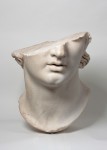 Earlier this year, the Metropolitan Museum of Art presented more than 265 artifacts from the Hellenistic period in the exhibition Pergamon and the Hellenistic Kingdoms of the Ancient World. As the title suggests, most of the pieces on display came from Pergamon, an ancient city of the Aegean which is now in western Turkey. The largest and most dramatic object on display was a monumental statue of the goddess Athena, on loan from Berlin’s Pergamon Museum.
Earlier this year, the Metropolitan Museum of Art presented more than 265 artifacts from the Hellenistic period in the exhibition Pergamon and the Hellenistic Kingdoms of the Ancient World. As the title suggests, most of the pieces on display came from Pergamon, an ancient city of the Aegean which is now in western Turkey. The largest and most dramatic object on display was a monumental statue of the goddess Athena, on loan from Berlin’s Pergamon Museum.
The exhibition closed on July 17th, but the Pergamon Museum agreed to extend the loan of Athena and another colossal piece, the fragmentary head of a youth, for two more years. The Berlin museum is currently undergoing an extensive refurbishment and will be closed until 2019, so this arrangement is advantageous for both parties.
On August 4th, the statue of Athena was moved to the southern side of the Met’s Great Hall and the installation process was filmed because it’s cool.
 The statue was modeled after the famous monumental gold and ivory statue of Athena by Phidias that stood inside the Parthenon in Athens for a thousand years from the 5th century B.C. until the 5th century A.D. Phidias’ vision of the patron goddess of Athens was iconic in antiquity and it was widely copied for centuries. This version was made around 170 B.C. and it’s not an exact replica. It’s smaller in scale — 12 feet high to the original’s 40 feet — with a more simple helmet, no shield, no column on the side and therefore probably no small figure of Nike in Athena’s hand outstretched just above the column, and no serpent sidekick which was a symbol of Athena as protector of the Acropolis and thus not relevant to Pergamon’s interests. On the base is a carved relief with six figures depicting the birth of Pandora, as on the pedestal of the original. The base of the Pergamon statue is heavily damaged, however, with significant chunks of the relief missing.
The statue was modeled after the famous monumental gold and ivory statue of Athena by Phidias that stood inside the Parthenon in Athens for a thousand years from the 5th century B.C. until the 5th century A.D. Phidias’ vision of the patron goddess of Athens was iconic in antiquity and it was widely copied for centuries. This version was made around 170 B.C. and it’s not an exact replica. It’s smaller in scale — 12 feet high to the original’s 40 feet — with a more simple helmet, no shield, no column on the side and therefore probably no small figure of Nike in Athena’s hand outstretched just above the column, and no serpent sidekick which was a symbol of Athena as protector of the Acropolis and thus not relevant to Pergamon’s interests. On the base is a carved relief with six figures depicting the birth of Pandora, as on the pedestal of the original. The base of the Pergamon statue is heavily damaged, however, with significant chunks of the relief missing.
 It was discovered in the Sanctuary of Athena in Pergamon in 1880. The body was found behind the North Stoa in front of the largest rooms in the sanctuary which may have housed the Pergamon Library. The head was found in a courtyard in front of the remains of the North Stoa. The body, head, base and arms of the statue were made separately and joined together, which is why the head fits in like a puzzle piece as you can see in the installation video. The arms are now lost.
It was discovered in the Sanctuary of Athena in Pergamon in 1880. The body was found behind the North Stoa in front of the largest rooms in the sanctuary which may have housed the Pergamon Library. The head was found in a courtyard in front of the remains of the North Stoa. The body, head, base and arms of the statue were made separately and joined together, which is why the head fits in like a puzzle piece as you can see in the installation video. The arms are now lost.
The monumental statues will be on display in the Great Hall until fall of 2018.